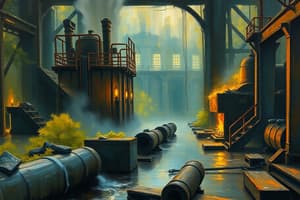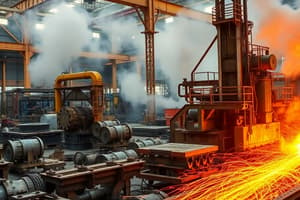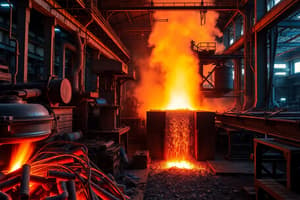Podcast
Questions and Answers
What is a significant trend in the steel industry aimed at improving sustainability?
What is a significant trend in the steel industry aimed at improving sustainability?
- Increased use of traditional blast furnaces
- Greater reliance on imported steel
- Reduction of automation in production processes
- Utilization of electric arc furnaces (correct)
Which factor is NOT a key consideration in steel production?
Which factor is NOT a key consideration in steel production?
- Sourcing raw materials at a reasonable price
- Competition in international markets
- Balancing efficiency with sustainability
- Customer branding strategies (correct)
How do global economic conditions affect the steel market?
How do global economic conditions affect the steel market?
- They ensure stable steel prices
- They trigger changes in market demand (correct)
- They eliminate the need for raw materials
- They reduce the importance of regulatory standards
What role do regulatory standards play in the steel industry?
What role do regulatory standards play in the steel industry?
Which production method reflects a trend towards resource efficiency in the steel industry?
Which production method reflects a trend towards resource efficiency in the steel industry?
Which country is the largest producer of steel in the world?
Which country is the largest producer of steel in the world?
What impact do technological advancements have on steel production?
What impact do technological advancements have on steel production?
What is a primary consideration when selecting a steel production method?
What is a primary consideration when selecting a steel production method?
How does global steel demand impact the economy?
How does global steel demand impact the economy?
What factor does NOT significantly influence the location of steel mills?
What factor does NOT significantly influence the location of steel mills?
Which production method is primarily used for recycling scrap metal?
Which production method is primarily used for recycling scrap metal?
What is one of the main environmental concerns associated with steel production?
What is one of the main environmental concerns associated with steel production?
What primarily drives investment in new steel facilities and upgrades?
What primarily drives investment in new steel facilities and upgrades?
Which mechanical property is crucial for a material's ability to undergo plastic deformation before breaking?
Which mechanical property is crucial for a material's ability to undergo plastic deformation before breaking?
What is the importance of thermal conductivity in material selection?
What is the importance of thermal conductivity in material selection?
Which factor is primarily influenced by the desired service environment when selecting materials?
Which factor is primarily influenced by the desired service environment when selecting materials?
Which property reflects a material's ability to resist surface indentation or scratching?
Which property reflects a material's ability to resist surface indentation or scratching?
In material selection, which factor can significantly affect sustainability considerations?
In material selection, which factor can significantly affect sustainability considerations?
Which factor is NOT considered when assessing a material's corrosion resistance?
Which factor is NOT considered when assessing a material's corrosion resistance?
What aspect of thermal properties is crucial for designs exposed to fluctuating temperatures?
What aspect of thermal properties is crucial for designs exposed to fluctuating temperatures?
What property is crucial for a material placed in high-temperature conditions?
What property is crucial for a material placed in high-temperature conditions?
Which mechanical property indicates the material’s ability to withstand applied loads without failure?
Which mechanical property indicates the material’s ability to withstand applied loads without failure?
Which of the following best describes the concept of 'dimensional stability' in design requirements?
Which of the following best describes the concept of 'dimensional stability' in design requirements?
What is the primary focus of evaluating a material's chemical properties in the selection process?
What is the primary focus of evaluating a material's chemical properties in the selection process?
Which factor affects the machinability of a material?
Which factor affects the machinability of a material?
What is the primary concern when evaluating a material's welding capabilities?
What is the primary concern when evaluating a material's welding capabilities?
Which of these is NOT a service environment consideration for materials?
Which of these is NOT a service environment consideration for materials?
Which property relates to a material's ability to endure external loads without failure?
Which property relates to a material's ability to endure external loads without failure?
What is a key factor influencing material selection regarding sustainability?
What is a key factor influencing material selection regarding sustainability?
Which characteristic is NOT associated with metals?
Which characteristic is NOT associated with metals?
What defines a composite material?
What defines a composite material?
Which statement best describes ceramics?
Which statement best describes ceramics?
Which property of polymers is a significant limitation in their use?
Which property of polymers is a significant limitation in their use?
What is the primary role of the matrix phase in composite materials?
What is the primary role of the matrix phase in composite materials?
Which of the following materials is considered a natural polymer?
Which of the following materials is considered a natural polymer?
Which of the following statements about metals is true?
Which of the following statements about metals is true?
In what way are ceramics beneficial in engineering applications?
In what way are ceramics beneficial in engineering applications?
Flashcards
Steel production sustainability
Steel production sustainability
Efforts to reduce the environmental impact of steel production, often utilizing alternative methods like electric arc furnaces.
Steel price fluctuation
Steel price fluctuation
Steel prices change based on supply and demand in the market.
Steel production efficiency
Steel production efficiency
Maximizing output while minimizing resource use in steel production.
International steel market competition
International steel market competition
Signup and view all the flashcards
Steel production impact of regulations
Steel production impact of regulations
Signup and view all the flashcards
Global Steel Production
Global Steel Production
Signup and view all the flashcards
Key Steel Producing Countries
Key Steel Producing Countries
Signup and view all the flashcards
Blast Furnace Steel Production
Blast Furnace Steel Production
Signup and view all the flashcards
Electric Arc Furnace (EAF)
Electric Arc Furnace (EAF)
Signup and view all the flashcards
Steel Production Methods
Steel Production Methods
Signup and view all the flashcards
Steel Production Impact
Steel Production Impact
Signup and view all the flashcards
Global Steel Demand
Global Steel Demand
Signup and view all the flashcards
Environmental Steel Impact
Environmental Steel Impact
Signup and view all the flashcards
Corrosion Resistance
Corrosion Resistance
Signup and view all the flashcards
Oxidation Resistance
Oxidation Resistance
Signup and view all the flashcards
Machinability
Machinability
Signup and view all the flashcards
Weldability
Weldability
Signup and view all the flashcards
Castability
Castability
Signup and view all the flashcards
Formability
Formability
Signup and view all the flashcards
Load-bearing Capacity
Load-bearing Capacity
Signup and view all the flashcards
Dimensional Stability
Dimensional Stability
Signup and view all the flashcards
Material Selection
Material Selection
Signup and view all the flashcards
Strength
Strength
Signup and view all the flashcards
Ductility
Ductility
Signup and view all the flashcards
Thermal Conductivity
Thermal Conductivity
Signup and view all the flashcards
Coefficient of Thermal Expansion
Coefficient of Thermal Expansion
Signup and view all the flashcards
Service Environment
Service Environment
Signup and view all the flashcards
What are the four main material classes?
What are the four main material classes?
Signup and view all the flashcards
What makes metals unique?
What makes metals unique?
Signup and view all the flashcards
Polymers
Polymers
Signup and view all the flashcards
What are ceramics known for?
What are ceramics known for?
Signup and view all the flashcards
What are composites made of?
What are composites made of?
Signup and view all the flashcards
Alloy
Alloy
Signup and view all the flashcards
Study Notes
Global Steel Production Overview
- The global steel industry is a massive and complex sector, encompassing a wide range of production methods, countries, and applications.
- Major steel-producing nations often have significant domestic demand, contributing to their production volumes.
- Raw material availability and cost are crucial factors influencing production locations and profitability.
- Technological advancements play a vital role in optimizing production processes, improving efficiency, and reducing costs.
- Significant investment in new facilities and upgrades is common, often driven by the need for improved capacity and new technologies.
- Global steel trade patterns are influenced by economic conditions, tariffs, and trade agreements impacting supply chains and pricing.
Key Steel Producing Countries
- China dominates global steel production, holding a significant market share, due to its substantial resources and infrastructure.
- Other countries with substantial production include India, Japan, South Korea, and the United States.
- Regional variations in steel production capacity exist.
- Factors like raw material availability, labor costs, and government subsidies can affect the competitiveness of steel producers in different regions.
- Factors such as market demand and raw materials influence the location of steel mills.
- Trade disputes, international agreements, and quotas can impact steel production and distribution in different countries.
Steel Production Methods
- Blast furnace is a traditional and significant method for steel production.
- Electric arc furnaces (EAFs) are also a key production method, especially for scrap metal.
- The selection of a specific production method is generally driven by cost concerns, raw material characteristics, and the type of steel being produced.
- Minimizing environmental impact from steel production remains a global priority, driving innovation in refining processes.
Impact of Steel Production
- Steel plays a critical role in infrastructure projects, construction, manufacturing, and consumer goods around the globe.
- The industry's consumption level heavily dictates the global economy's health and activities.
- Global steel demand is influenced by large-scale construction projects, industrial activity, and consumer spending habits.
- The environmental impact of steel production is substantial, leading to concerns about pollution and resource depletion.
- This concern has driven development of sustainability initiatives and alternate steel production methods (e.g., using electric arc furnaces and using scrap metals).
- Steel production is intertwined with national economies and can be a major driver of employment and economic growth.
Steel Market Trends
- Technological advancement of the steel industry is focused on sustainable production methods, reduced environmental footprint, and enhanced efficiency.
- The rise of electric arc furnaces alongside an increased use of scrap steel demonstrates a trend toward resource efficiency in the steel industry.
- Steel prices are susceptible to fluctuating supply and demand dynamics.
- The interplay between economic growth, regulatory standards, and technological advancement shapes the steel industry's evolution.
- Shifts in regulations related to emissions and waste disposal often directly affect steel production practices.
- Global economic conditions are a crucial component that triggers changes in the steel market's demand.
Key Considerations in Steel Production
- Balancing efficiency with sustainability.
- Competition in international markets.
- Sourcing raw materials at a reasonable price to increase profitability.
- The growing trend is to make production more environmentally friendly as sustainability is a global priority.
- Supply chain logistics are pivotal in how steel is shipped and processed.
- Steel production is influenced by policies implemented at the local, national, and international levels.
Studying That Suits You
Use AI to generate personalized quizzes and flashcards to suit your learning preferences.




